
- Virtual Reality
- Video-Based Learning
- Screen Capture
- Interactive eLearning
- eLearning Resources
- Events and Announcements
- Adobe Learning Manager
- Adobe Connect
- Recent Blogs
- VR projects
- From your computer
- Personalize background
- Edit video demo
- Interactive videos
- Software simulation
- Device demo
- System audio / narration
- High DPI / Retina capture
- Responsive simulation
- Full motion recording
- Advanced actions
- Conditional actions
- Standard actions
- Execute Javascript
- Shared actions
- Learning interactions
- Drag and Drop interactions
- eLearning Community
- Tutorials/Training
- Deprecated features
- Support questions
- New version
- Reviews/Testimonials
- Sample projects
- Adobe eLearning Conference
- Adobe Learning Summit
- Customer meetings
- Announcements
- Adobe Captivate Specialist Roadshows
- Account settings
- Active fields
- Activity modules
- Adobe Captivate Prime
- Auto enrollment using learning plans
- Automating user import
- LMS Branding
- Certifications
- Classroom trainings
- Content curation
- Content storage
- Course level reports
- Create custom user groups
- Customize email templates
- Default fields
- eLearning ROI
- Employee as learners
- Extended eLearning
- External learners
- Fluidic player
- Gamification and badges
- getAbstract
- Harvard ManageMentor
- Integration with Adobe Connect and other video conferencing tools
- Integration with Salesforce and Workday
- Integration with third-party content
- Integrations
- Internal and external users
- Internal server
- Learner dashboard
- Learner transcripts
- Learning objects
- Learning plan
- Learning programs
- Learning styles
- LinkedIn Learning
- LMS implementation
- Managing user groups
- Multi tenancy
- Multi-scorm-packager
- Overview of auto-generated user groups
- Prime integration
- Self-Paced trainings
- Set up announcements
- Set up external users
- Set up gamification
- Set up internal users
- Single sign-on
- Social learning
- Tincan/xAPI
- Types of course modules
- Virtual classroom trainings
- Accessibility
- Adobe Connect Mobile
- Breakout Rooms
- Case Studies
- Collaboration
- Connectusers.com
- Customer Stories
- Product updates
- Social Learning
- Virtual Classrooms
- Virtual Conferences
- Virtual Meetings
- Unified Communications
- Free Projects
- Learning Hub
- Discussions
- eLearning Community Follow
True learning and implied behavior change requires a learning journey to boost professional development and achieve improved performance. In this article, we look at the link between learning journeys and how it can improve employee performance.
True learning and implied behavior change requires a learning journey to boost professional development and achieve improved performance. In this article, I look at the link between learning journeys and how it can improve employee performance.

What Is a Learning Journey?
Traditional training has often been viewed as a one-time event: a training class, a webinar, a learning module.
However, if the goal of training is a change in behavior, which leads to improved employee performance, training should, instead, be viewed as a learning journey – a series of learning events made up of a blend of formal and informal interventions, nudges, and follow-ups that ingrain new knowledge and behavior in employees.
- Formal training is one of the key elements of a learning ecosystem that typically facilitates the learning acquisition.
- As you add informal training (some initiated by L&D teams, some initiated by individuals and coached by leaders), you create a learning journey.
Why Should You Invest in Learning Journeys?
Learning is the key to thriving business.
In the animal kingdom of North America, the coyote has perhaps proven to be the most apt at learning and has therefore thrived. When Meriwether Lewis in the early 19 th century first encountered a coyote on his famous exploration, he was perhaps the first of European descent to see one. He attempted to kill and collect it as a new specimen. He and his men were unsuccessful though – an experience that thousands of American hunters have shared since. The coyote has learned to adapt and thrive to constant changes in their ecosystem and are now a common sighting in large cities like San Francisco (California) and Salt Lake City (Utah).
In business, those who can learn are the coyotes – they can adapt and thrive to changing circumstances. Companies should find and develop coyotes in their organizations – employees who actively participate in their own learning journeys and contribute to the journey of their coworkers.
From a business perspective , learning journeys provide highly customized programs that are structured around key enterprise goals and objectives. Leaders should provide this insight to help prepare their organization for future challenges.
Not only does this help futureproof their business by driving incremental and disruptive innovation but it also improves employee engagement. Employees are looking for organizations that value learning and encourage professional development.
Organizations benefit from employees who continuously strive for improvement.
From the employee’s perspective , the learning journey acts as a GPS that guides learners in their efforts, through formal and informal learning, to perfect their art by acquiring new skills and proficiencies in business domains and technological mastery. These GPSs guide learners through motivation, awareness, learning consumption, and knowledge application.
Learning journeys comprise formal and informal learning – opportunities to acquire skills for a specific role or technological domain. They are highly relevant to the individual, assisting him/her with his/her career aspirations.
What Do You Need to Consider While Creating an Effective Learning Journey?
The following are vital issues to consider when building learning journeys:
- Look at the big picture and consider that, while foggy, the future is ever present. Learning occurs over prolonged time and should never been something that employees stop doing, nor should organizations ever rest on their previous laurels.
- Awareness : Before employees can begin a learning journey, they need to be aware of what is available, how the organization will support them, and what lies ahead.
- Motivation : While some employees are motivated for the pure sake of learning, some are looking for additional extrinsic motivations. Organizations should set up systems to reward progression in the learning process, encouraging employees to begin and continue the learning journey.
- Participation and experimentation : Throughout the learning journey, employees need a safe space to participate, digest, apply, and experiment with the new knowledge they’re gaining through the learning journey. The experimentation and feedback loop are key to achieving behavior change.
- On-going connects: Design learning journeys that include more than formal training events. Develop guides for managers to follow-up with employees on what they learned, implement social and mobile learning strategies, and allow employees to direct much of their own informal learning.
What Are Key Aspects that Would Help You Create Effective Learning Journeys?
Leverage the following aspects when developing learning journeys:
- Start with the end in mind : Planning is too often abbreviated in the L&D field, a reaction to develop content as quickly as possible to please business stakeholders. Remember what Albert Einstein said about planning: “If I had an hour to solve a problem, I’d spend 55 minutes thinking about the problem and 5 minutes thinking about solutions.”
- Include all stakeholders: During the initiation phase, include key stakeholders and ensure that everyone involved in the process has the information they need. Leaders should ask themselves the following questions: What do I know? Who needs to know? Have I told them?
- Build awareness of the solution with the target audience : Begin with primers to help them understand the big picture of the learning journey. Include an exposition on the current state, the desired future state, and the differences between those two states. Use microlearning hits that get to the point quickly.
- Stimulate prior knowledge with which learners can scaffold new information.
- Present content in the most appropriate modality.
- Model learning strategies to help students assimilate new information.
- Include as much application and practice as possible with healthy feedback loops.
- Assess performance, giving additional feedback to learners.
- Once learners are back on the job, use informal learning and coaching nudges to reinforce the application of new knowledge on the job. Employ performance support systems so learners can quickly find and share information they need in the flow of work.
- Reward behavior change : While punitive rewards may be effective in the short term, for effective long-term behavior change, learning journeys should offer employees as much purpose, autonomy, and mastery as possible. Once employees are paid a fair and competitive wage, purpose, autonomy, and mastery are more effective methods of motivation than even bonus models.
Making It Work – EI Design’s Learning and Performance Ecosystem Based Approach to Create Effective Learning Journeys
EI Design has developed a highly effective model for creating effective learning journeys in a Learning and Performance Ecosystem. It’s a cyclical model that includes the following:
- Capture attention about learning opportunities.
- Explain what employees will gain from the learning journey ( what’s in it for me ).
- Leverage immersive formal learning events that employ gamification, virtual and augmented reality, scenario based learning, and branching scenarios.
- Support formal events with performance support tools , giving employees access to information in the flow of work: exactly what they need, when they need it.
- Reinforce learning after formal events with safe places to practice and receive feedback on their performance.
- Provide social learning so that learners can collaborate with others progressing in the learning journey, sharing knowledge and experiences.
Parting Thoughts
Effective behavior change occurs over time as desired competencies and behaviors are reinforced through a blend of formal and informal training. Learning is not a onetime event. Professionals seek mastery of their trade, striving for autonomy and purpose. Learning journeys, thoughtfully developed and shared with employees, are an effective method of facilitating behavior change that aligns to enterprise goals and initiatives.
I hope this article provides the requisite insights on how you can use our unique Learning and Performance Ecosystem to create effective learning journeys and boost employee performance.

You must be logged in to post a comment.

- SUGGESTED TOPICS
- The Magazine
- Newsletters
- Managing Yourself
- Managing Teams
- Work-life Balance
- The Big Idea
- Data & Visuals
- Reading Lists
- Case Selections
- HBR Learning
- Topic Feeds
- Account Settings
- Email Preferences
Data & Visuals

Partner Center
Crucial Skills®
A blog by crucial learning, trainer insights, maps, paths, and destinations: how to plan for a successful learning journey.
Many years ago, my husband and I set out on a spontaneous weekend trip: no hotel reservations, no agenda, no destination. Our plan was simply to see where the road would take us.
As we began our journey, we decided not to go very far from home, opting to spend more time enjoying whatever destination we chose. Along the way we spotted a billboard for a highly recommended restaurant about 30 miles away. We decided to splurge on dinner and use that as the anchor for our getaway.
Destination decided, we had a great day adventuring in the area, finding shops in small rural communities and making discoveries close enough to home to be enjoyed again. At the end of the day, we drove up to the entrance to the rustic but elegant dining room, excited about sampling an eclectic and upscale menu.
The restaurant was closed for remodeling.
Our entire day had been planned around this location and this end goal. We sat for a minute looking at the darkened windows and the rather cheerful “See you soon” sign, wondering what to do next. What to do now that our plans (poorly laid as they were) had radically changed?
The short end of that story is that we got dinner—at the local Dairy Queen. While filling, it was not the glorious ending to our day we had envisioned.
Rolling out high-impact training and realizing effective behavior change in an organization is a journey. Planning carefully and having a clear goal in mind at the outset will give you not only improved performance but will also help you reach those destinations most important to your organization.
The first step is to understand your why . Knowing that you have made a difference in your organization is what drives good trainers to become great facilitators—and that often starts with understanding the answer to these four questions:
- Why are you bringing the content to your organization?
- What business outcomes do you want to achieve?
- How does the course tie into your organization’s initiatives?
- What are your organization’s biggest needs?
As you evaluate the answers to these questions, chances are your responses will relate to skill acquisition, organization initiatives, or culture change.
Once you have determined your why, it’s time to create an action plan . The strategic decisions in your plan are very likely the most important and should be centered around people (the who), marketing (the how), and course delivery (the where).
We often get excited about taking off on that proverbial road trip without a clear map or having verified the destination. Be patient at the decision-making step! This is your map.
When my husband and I started on our trip, we chose a very haphazard approach. While this sounded fun at the time, the lack of clear decision making and strategic planning left us scratching our heads at the end of the day. For training programs to be effective, you need to make careful, thoughtful decisions with a clear end in mind. This will provide a return on expectations to savor at the end of the journey.
Once you’ve made decisions (with support from your key stakeholders), you’re ready to make it happen .
This is the fun part! This is standing in the classroom and greeting your participants. This is watching people engaged in a virtual poll or come back from a breakout session saying that they wished they had more time to talk. This is the part that gives every trainer I know that “fizz.”
But as enjoyable as this part is, it too requires thoughtful preparation.
Whether you are facilitating in person or virtually, it is important to have a checklist and to practice. Even very experienced trainers sometimes forget their clicker or misplace their laptop charger. Having a tried-and-true checklist and running through your presentation at least three times will give you the foundation to confidently deliver your course, whether you have taught once or hundreds of times.
You have created a great map, you know your destination, you have made it happen—your participants have carried you out of the room on their shoulders as the hero of the day. Now what? How do you make it stick ?
Without follow up, sustaining the skills learned can be like the restaurant closed for remodeling. You were hoping for high-end cuisine and got a burger and fries instead.
Ensure that your investment of time, energy, and training dollars achieves the desired impact with after-training resources, engaging mini-learning sessions, and effective measurement. Measurement is where you can connect outcomes back to your purpose. Did the map you created get you to your destination? Were all the lights on when you arrived? Did you get to savor the product of all your hard work?
The end of that spontaneous road trip with my husband, while comical, was not what we had hoped for—but it was a direct reflection of what we had planned. Learning and development professionals have enormous influence in organizations. It is in carefully and thoughtfully planning a high-impact learning journey that we move from good courses to great training experiences with the power to change lives.
For additional help planning your learning journey, check out our implementation guide .
Share this:

Solutions Implementation Consultant and Master Trainer
Reta is passionate about learning and understands different learning styles. For more than 10 years she has worked in training and development, and managed leadership development programs for a Fortune 100 company. She's a brilliant storyteller, trainer and coach, and brings enthusiasm to everything she does.
Develop Your Crucial Skills
What's your style under stress.
Discover your dialogue strengths and weaknesses with this short assessment.
Take Assessment
Subscribe Now
Subscribe to the newsletter and get our best insights and tips every Wednesday.
Ask a Question
From stubborn habits to difficult people to monumental changes, we can help.
Leave a Reply Cancel reply

- Search entire site
- Search for a course
- Browse study areas
Analytics and Data Science
- Data Science and Innovation
- Postgraduate Research Courses
- Business Research Programs
- Undergraduate Business Programs
- Entrepreneurship
- MBA Programs
- Postgraduate Business Programs
Communication
- Animation Production
- Business Consulting and Technology Implementation
- Digital and Social Media
- Media Arts and Production
- Media Business
- Media Practice and Industry
- Music and Sound Design
- Social and Political Sciences
- Strategic Communication
- Writing and Publishing
- Postgraduate Communication Research Degrees
Design, Architecture and Building
- Architecture
- Built Environment
- DAB Research
- Public Policy and Governance
- Secondary Education
- Education (Learning and Leadership)
- Learning Design
- Postgraduate Education Research Degrees
- Primary Education
Engineering
- Civil and Environmental
- Computer Systems and Software
- Engineering Management
- Mechanical and Mechatronic
- Systems and Operations
- Telecommunications
- Postgraduate Engineering courses
- Undergraduate Engineering courses
- Sport and Exercise
- Palliative Care
- Public Health
- Nursing (Undergraduate)
- Nursing (Postgraduate)
- Health (Postgraduate)
- Research and Honours
- Health Services Management
- Child and Family Health
- Women's and Children's Health
Health (GEM)
- Coursework Degrees
- Clinical Psychology
- Genetic Counselling
- Good Manufacturing Practice
- Physiotherapy
- Speech Pathology
- Research Degrees
Information Technology
- Business Analysis and Information Systems
- Computer Science, Data Analytics/Mining
- Games, Graphics and Multimedia
- IT Management and Leadership
- Networking and Security
- Software Development and Programming
- Systems Design and Analysis
- Web and Cloud Computing
- Postgraduate IT courses
- Postgraduate IT online courses
- Undergraduate Information Technology courses
- International Studies
- Criminology
- International Relations
- Postgraduate International Studies Research Degrees
- Sustainability and Environment
- Practical Legal Training
- Commercial and Business Law
- Juris Doctor
- Legal Studies
- Master of Laws
- Intellectual Property
- Migration Law and Practice
- Overseas Qualified Lawyers
- Postgraduate Law Programs
- Postgraduate Law Research
- Undergraduate Law Programs
- Life Sciences
- Mathematical and Physical Sciences
- Postgraduate Science Programs
- Science Research Programs
- Undergraduate Science Programs
Transdisciplinary Innovation
- Creative Intelligence and Innovation
- Diploma in Innovation
- Transdisciplinary Learning
- Postgraduate Research Degree
How do Learning Journeys work?
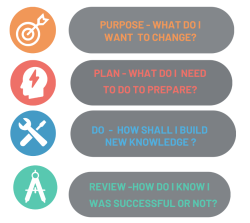
Life is full of learning experiences and opportunities. We learn at school, at home, in the workplace, and in the community. It can be useful to think about how we learn as a journey. Like any journey, you’re directing the course. There is a starting point, a destination and waypoints along the way. There are also tools that can help you navigate the terrain and you need fuel to keep you going.
Thinking about learning in this way can help you achieve your goal or aim, and improve the way you learn. There are four steps in a learning journey:
The first step in a learning journey is to find your purpose. It’s a good idea to ask yourself why you are doing something. Understanding the reason behind your actions will set you on a clear Learning Journeys path. Ask yourself what you want to achieve.
The next step is to figure out where you are in your journey and discover ways you can move forward. This is where your Learning Power comes into play. Learning Power is like the fuel that drives you on your learning journey. Learning Power improves your potential to succeed. To understand your unique Learning Power you can answer questions about how you think, feel and behave when you are learning. How you answer these questions will generate your Learning Power Profile.
Your Learning Power Profile is displayed in the form of a spider diagram as well as an orientation to learning indicator. It presents quantitative data about the dimensions of Learning Power. You can use your Learning Power Profile to grow your awareness around the way you learn and to develop your ability to work towards achieving your goal or purpose. Here is an example of a Learning Power Profile and the Orientation to Learning Indicator:

Once you have diagnosed your own Learning Power and received your Learning Power Profile you’re ready to use it as a framework to plan the direction of your learning journey. How can you use your profile to improve the way you learn? How can you build your learning power? Was there one specific learning dimension you want to focus on? How can the dimensions you’re strong in help you in the areas you want to grow? Understanding how you learn, what you’re good at and how you can improve means you can now take the necessary steps to achieve success.
There are several resources to help you figure out what does my Learning Power profile mean?
Now it’s time to put your plan into action, and often this will mean doing something different. While moving forward on your learning journey, navigating the terrain and working towards your goal, you might discover new ways of doing things, be exposed to new ideas and/or change your approach to old problems. It’s all about using your Learning Power to fuel purposeful and meaningful action.
It’s also important to keep track of your progress throughout your learning journey in order to see how you’ve changed. When you feel you’ve developed throughout your learning journey you can complete your Learning Power Profile again, and then reflect again on what it might be telling you .
Take time to think about what you’ve learned. What new knowledge have you generated? Have you met the targets you set yourself? Has your learning power improved? Can you show any evidence of your progress? And how have you changed as a result of your learning journey?
Don't forget...
The profile provided by Learning Journeys is contextual – that means your Learning Power Profile is determined by your perception of yourself at a point in time and in relation to the learning context (or contexts) in your mind at that time. The tool reflects changes in your perception of yourself as a learner and/or changes in your learning context. This means that learning facilitators and coaches can support you with strategies that improve your learning power.
What are Learning Dimensions?
There are nine dimensions of Learning Power, and these are the areas you can build on to help boost yourself along on your journey

UTS acknowledges the Gadigal people of the Eora Nation, the Boorooberongal people of the Dharug Nation, the Bidiagal people and the Gamaygal people, upon whose ancestral lands our university stands. We would also like to pay respect to the Elders both past and present, acknowledging them as the traditional custodians of knowledge for these lands.


How to Design an Effective Learning Journey
Explore best practices for how to create a learning journey and learn why this approach is crucial for a company’s leadership development strategy.
Publish Date: September 21, 2022
Read Time: 12 min
Author: Alex Smith
The traditional approach to learning journeys is no longer cutting it. Learning journeys have traditionally been designed to solve a leadership challenge over the course of a predefined time—6 or 12 months, for example. But at DDI, we know that learning journeys must be comprehensive and continuous over the course of a career and flexibly fit ever-changing leadership challenges. In this blog, I'll discuss why it's important for organizations to evolve their approach to learning journeys and shift away from "one and done" leadership programs. I'll also provide best practices for how to create learning journeys to support modern leaders in a fast-paced business world.
What Is a Learning Journey?
Traditionally, a learning journey has been defined as a unique plan that is founded on the challenges facing your organization and the most critical skills leaders need to achieve business success. It’s always been defined as an intentional, linear path to meet a business, leadership, or learning need. And it's sequential.
A learning journey has typically been designed for groups, cohorts, or communities of leaders. It takes place over time and incorporates a strategic mix of learning methods intended to meet the needs of today’s learner. It often begins with a review of relevant organizational and assessment data, the business drivers , and the target audience’s development gaps. L&D teams can use all of this information as the starting point for designing the learning journey.
While many elements of the traditional definition of a learning journey still ring true, learning journeys shouldn’t be completely linear. Learning journeys should still be designed to help a group of leaders solve broad organizational challenges. But it’s time to empower individual leaders within these journeys to take a unique pathway, outside of or in addition to the linear journey, to meet their personal learning or business needs.
Learning journeys must become more flexible and impactful as continuous, personalized journeys that follow the careers of the learners. And they shouldn’t track one path for all leaders. Learning journeys must be continuously analyzed and molded to fit the unique needs of each leader as their careers grow and change, always considering both the skills they uniquely need to grow and their preferred learning styles .
While journeys should be personalized to each leader’s unique learning needs, they must still be grounded in the context of the organization and highly connected to the overall goals of the business.
Reasons to Invest in Learning Journeys
It’s beneficial to invest in learning journeys because this approach to development ensures tight alignment with your organization’s strategies. Your leaders develop skills that are linked to your business needs, which has bottom-line implications.
According to DDI’s Global Leadership Forecast 2021 research, companies that use blended learning journeys compared to those that do not are 8 times more likely to have a highly-rated leadership development program, 5.8 times more likely to have a strong supply of leaders for critical roles, and 2.3 times more likely to be financially successful .
Additionally, implementing effective learning journeys can help companies engage and retain talent . Recent research from McKinsey shows that the top reason employees quit over the last year was because they lacked career development and advancement opportunities. If you’re not developing your people, they’re likely to head for the door. But not just any development will do. Make sure you’re following best practices for how to create a learning journey, which I’ll discuss more below.
Finally, effective learning journeys benefit leaders themselves. Simply put, when done right, learning journeys create better and more skilled leaders. And if you use blended learning strategies with group-based development or collaborative peer learning , leaders get the chance to network and build stronger relationships.
5 Best Practices for Creating Effective Learning Journeys
Now let’s jump into our five best practices for creating effective learning journeys. Learn how to ensure your learning approach is continuous, includes multiple modalities, has senior leader support, is personalized, and is data driven—and why it matters that you get these best practices right.

1. Effective Learning Journeys Are Continuous
Recall the traditional way of thinking about a learning journey: a waterfall of activities that’s typically “one and done.” It’s linear and pre-planned from the start. But what we know after years of developing leaders is that the most effective learning experiences are continuous as the learner gains new skills and discovers new areas they need to develop.
Learning journeys today evolve and adapt without a short-term end date. There may be an intentional starting approach, for example, a journey to upskill leaders in leading their teams in a hybrid workplace . The bulk of that learning may occur over a specific time frame, but there are also interactive self-guided tools built in to sustain learning long after.
In addition, a journey like this includes flexibility to start and stop depending on what a leader may have going on, and the capability to choose a learning style that fits their needs. Learning journeys like this are continuous to address all the moments of need across a leader’s career—both expected and unexpected moments. For example, learning journeys support a leader in their transition from an operational leader to a strategic senior-level role. But when there’s an unexpected major shift in the business like a merger, their journey helps them learn the new core skills to succeed in their company’s new landscape.
This next best practice for how to create a learning journey covers why it’s so important for leaders to choose the modality that fits their learning style.

2. Effective Learning Journeys Are Blended
We know from decades of surveying and talking with leaders that they prefer learning using a blend of modalities. This includes a mix of classroom learning with self-directed options and development assignments. We say that the magic is truly in the mix of modalities that work best for your leaders.
Plus, one thing we know as experts in learning and development is that people learn better when there’s variety in their learning journey . This variety keeps leaders’ engagement high and helps them make continuous new connections to concepts.
So what does variety of learning modalities mean? It means leaders have options to choose between virtual , in-person, or self-paced learning courses. Organizations can also offer microcourses , self-insight tools and assessments , games, simulations, and other digital tools to help leaders practice new skills on demand.
Offering a variety of digital and in-person learning experiences helps L&D professionals meet leaders in their moment of need . Meeting leaders in the moment means providing content and tools on a specific topic, challenge, or skill they need.
But sometimes digital or self-directed learning options get a bad rap because the right accountability structures aren’t in place for leaders. “Build it and they will come” is never an effective approach. However, there are ways to successfully implement self-directed leadership development. The key is that L&D professionals create a structure that makes learning happen better. For example, giving leaders time to process what they’re learning on their own, and then coming back together in peer learning groups to discuss what they learned. This is just one way to ensure self-directed learning sticks.

3. Effective Learning Journeys Are Supported by Senior Leaders
When senior leaders understand the value of your program, they can also communicate and champion it to employees, making learners more likely to participate.
Having senior leaders as stakeholders who back your program can make all the difference. They can help ensure that your program is connected to your business strategy. And the more buy-in you have from the top, the more your program will be socialized within the organization. When it’s time for investment decisions about your program, senior leaders are more likely to feel ownership for current success. This can lead to more budget coming your way for expansion and improvements.
It’s also important to consider support where it matters most for your learners: their own managers should support their learning journey and development. This is a great article that offers strategies for securing manager support for leadership development .

4. Effective Learning Journeys Are Personalized
Why does personalization make a difference for learners? When development is personalized, it feels relevant. Personalized development is relevant because it's also anchored on your business context. Leaders want to connect how their development will drive success for themselves as well as for the organization.
But personalizing a learning journey must be grounded in self-insight and data. Leadership assessments can provide leaders with data on their strengths and gaps. This data can be used to influence and bring focus to a leader’s learning journey—both at the individual and group level.
When it comes to personalized learning journeys , make sure that if it’s not completely evident to your leaders that it is personalized, you directly communicate it as such. I’ve seen leaders respond well to a message like, "This is personalized for you, and here's how we did that." Communicating that your programs are personalized can help with adoption. It can also create excitement for leaders to get started on development that was built especially for them!

5. Effective Learning Journeys Are Data Driven
Being data driven allows learning journeys to be more flexible and adaptable, which is important in our ever-changing business landscape. Using data can help you pivot quickly and shift a learning journey to respond to major organizational changes. For example, self-assessment data from a company’s leaders who have recently completed a merger can show skill gaps in a newly formed group of leaders.
It’s also important to collect data at different points of your program to help you understand what’s working and what’s not. Knowing what’s effective can help you adjust the learning journey along the way according to the changing goals and needs of the learner—and your organization.
For example, measurement tools can be used to evaluate the program’s impact on your leader’s reactions, learning, and behavior change, and on organization-level metrics. Having data readily available on the impact of your leadership programs can help you highlight their success. And being able to prove the worth of your program can be crucial to sustaining your program (and your job as an L&D professional!) during disruptive times when budgets are under more scrutiny.
But more than that, being able to connect organization-level metrics to your leadership program metrics can help you see how the quality of leadership truly impacts company performance.
Implementing Effective Learning Journeys
Even the most thought-out learning journey can flop if it’s not implemented in the right way. So what are some best practices for implementing a learning journey?
We’ve already discussed some keys to implementation in this blog. It’s important to measure and track the results of your learning journey, including gathering data along the way. It’s also important to gain stakeholder engagement to help you influence, support, and accelerate your learning program.
Additionally, focus on creating a communication strategy to get everyone excited about their learning journey. This includes thoughtfully considering how you’ll kick off your learning program .
(For more on how to successfully implement your leadership development efforts, check out our Ultimate Guide to Leadership Development .)
In Conclusion:
Learning journeys done well create behavior change and adapt to change.
What a learning journey does best is create behavior change by reinforcing a blend of formal, self-guided, and peer-interactive development activities. Learning must be continuous to make progress toward mastery of competency areas.
But the best learning journeys are also flexible and open to change. After all, as the Prime Minister of Canada, Justin Trudeau , said “The pace of change has never been this fast, yet it will never be this slow again.”
Learning and development professionals have certainly gotten used to change over the past several years. Let’s remain adaptable to keep learning journeys relevant for leaders with constantly changing roles and challenges.
Learn more about how to create a learning journey for your leaders .
Alex Smith is a consulting manager within DDI’s US Operations. He leads a team of consultants and is the engagement manager for several of DDI’s largest client partnerships across the globe.
Topics covered in this blog
- Leadership Development
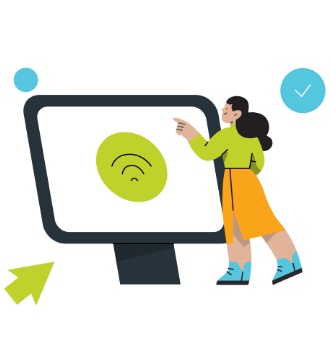
Leadership news straight to your inbox
Subscribe to curate your preferred list of leadership research, blogs, podcasts, newsletters, webinars, and more that comes to your email inbox hot off the press.
Learning Through Reflection: 20+ Questions to Inspire Others

It seems that our reflective ability to think about our thinking , known as metacognition, can provide a boost in all sorts of situations, especially when acquiring knowledge and skills (Fleming, 2021a).
While there was a time when we believed that rote learning , memorizing information based on repetition, was the path to good education, it now appears insufficient for our rapidly changing world, where we constantly need to get to grips with new ideas (Fleming, 2021b).
In this article, we explore the potential of reflection to help us understand how to think and learn and some activities that can help.
Before you continue, we thought you might like to download our three Positive Psychology Exercises for free . These science-based exercises will explore fundamental aspects of positive psychology including strengths, values, and self-compassion, and will give you the tools to enhance the wellbeing of your clients, students, or employees.
This Article Contains:
The role of reflection in learning, fostering reflection: 4 skills for teachers, 11 best questions for kids and students, 4 fun ways to cultivate reflection, questions to ask older students, positivepsychology.com’s reflection resources, a take-home message.
Humans are very good at explaining what they do and why. Self-awareness is, after all, one of our defining features. The capacity to do so relies on our ability to reflect on ourselves, such as how we think, feel, perceive, and decide things in our lives (Fleming, 2021b).
Reflection and introspection in learning are crucial, and the more accurate, the better. Both under- and overconfidence in our knowledge and abilities can lead us to fail to perform at our best.
For example, thinking we know something well when we don’t can leave us unprepared and oblivious that we can’t answer the question or perform the task. Conversely, never feeling we know enough may stop us from engaging in an activity or interacting with a group (Fleming 2021b).
Why is metacognition important?
Perhaps surprisingly, it is only in recent years that metacognition has been considered a valid and valuable subject for research (Fleming, 2021a). After all, doesn’t it seem impossible that the brain can peer in on itself? Isn’t this a prerequisite for self-reflection?
In fact, the brain can and does.
Findings from neuroscience and cognitive science research prove that the brain is not a single, indivisible organ. The brain is a collection of networks and has the capacity to think about its own thinking (Fleming 2021a).
In an ever-changing world where people live longer, change jobs more frequently, and need new skills almost daily, learning is indeed lifelong. Being fixed in what we know and not recognizing where we have scope to develop is unhelpful and even harmful.
Understanding metacognition and using our reflection skills can help us in education and enhance our ability to acquire the skills we need throughout life. Crucially, it improves “the way we make decisions about how, what, and when to study,” says Stephen Fleming (2021b, p. 116), a leading expert in neuroscience.
So how can reflection help us learn?
As it relates to learning, metacognition begins with us forming beliefs about how best to learn and where we should focus our attention (Fleming, 2021b). After all, it’s no good reading about the history of ancient Greece if the exam is on the Industrial Revolution.
Once we have learned what is needed, we can begin to understand how we should use or apply that knowledge. It could be an exam, a presentation at work, or a conversation with someone.
Fleming (2021b) lays out several important points to note when we look at learning from a metacognitive perspective:
- A considerable amount of research suggests that a preferred learning style (visual, written, auditory, etc.) may be a myth. Studies of learners who believed they had a pictorial learning style versus those with a verbal preference found their confidence was usually misplaced.
- It is crucial that we become aware of what we don’t know. Such reflective insight is helpful because it directs our focus where it is most needed. Sadly, we tend to choose what is more straightforward over the material or approach that will give us the most significant gains.
- Our overall confidence in how we perform is closely linked to our metacognitive bias. What this means is that even an unrealistic boost in our self-efficacy can lead to better performance.
Research has shown that metacognition, such as reflecting on what we do (and do not) know, what we need to learn, and the most appropriate learning approach, reduces anxiety and stress levels while boosting our results (Fleming, 2021b).
In the following sections, we look at how reflection can help teachers share knowledge and how students can utilize methods and questions to elevate their learning.

They studied teachers nominated by colleagues, professors, and educators as being “very adept at getting their students to think” (Ritchhart & Church, 2020, p. xvii).
What they found was simplified down to a three-word mantra for both teaching and learning:
Making thinking visible is vital.
Using a set of thinking routines, it is possible to “create classrooms where thinking is valued, visible, and actively promoted as part of the day-to-day experience of all members” (Ritchhart & Church, 2020, p. xv).
Teachers who encourage students to reflect on the process of learning and thinking create environments that (Ritchhart & Church, 2020):
- Cultivate deeper learning
- Foster engaged and motivated students
- Transform the typically fixed roles of teachers and students
- Improve the outcome of learning
- Change people’s thinking dispositions
And this deeper learning occurs at the point where the following three vital concepts meet (Ritchhart & Church, 2020):
- Mastery – the opportunity to develop an understanding
- Identity – the opportunity to connect with what was being studied and develop as a learner
- Creativity – the opportunity to produce something personally meaningful.
It is perhaps no surprise that this links closely to Ryan and Deci’s (2017) notion of intrinsic motivation being greatest when people are most engaged and feeling competent, related, and autonomous.
So how do we cultivate engaged students?
While thinking is typically an internal, seemingly inexplicable, process, it can be made visible through a set of reflective practices (Ritchhart & Church, 2020).
- Questioning : Great questions drive and make visible learning and thinking. Facilitative questions such as “ What makes you say that? ” are sometimes described as magic questions . They encourage the student to reflect, reveal, and engage with their deeper thinking to clarify their ideas. Similarly, “ Tell me why ” and “ What’s your reason for that? ” push for further explanation.
Crucially, the creative use of questioning by teachers switches the paradigm. Rather than attempting to transmit what is in their heads to their students, the goal becomes to understand the student’s thinking .
Such questions are not like the typical review questions used in a traditional class that simply require a recall verbatim of what the teacher said. They can be followed up with questions like “ Can you say more about that? ” and “ I’m not sure I follow. Can you say what you were thinking in a different way? ”
- Listening : It must be clear to students that teachers are truly interested in their thinking and what they are sharing. It gives the student a reason to impart their deeper thinking and present their theories.
The goal and skill of the teacher is to encourage deeper reflection by the student, drawing out their perspectives, feelings, and understandings regarding a situation or an idea.
Hearing the challenges, understandings, and even struggles within the student’s thinking, the teacher can find opportunities to explore and explain in greater detail without the student becoming overwhelmed or shutting down.
- Documentation : Thinking can seem like a messy process. However, even in the early stages of understanding and learning, documenting (e.g., observing, recording, interpreting, and sharing) can support the student’s reflective skills and the teacher’s growth.
Documentation is not merely what is captured, but also the act of reflecting on thinking and learning. Perhaps most importantly, when a teacher records the student’s ideas, it shows they have worth and value for future discovery.
Once visible, the students can reflect on their learning and make it a subject of discussion. A great question to set the scene is: “ What do I want to capture so that we as a class can return to it later for more careful examination and analysis? ” (Ritchhart & Church, 2020, p. 28).
- Thinking routines : Thinking routines can be shared with students and used as a structure to aid thinking, ultimately becoming a pattern of behavior.
Ritchhart and Church (2020) list eight thinking moves that are valuable for building understanding:
- Observing closely and describing what is there
- Building explanations and interpretations
- Reasoning with evidence
- Making connections
- Considering different viewpoints and perspectives
- Capturing the heart and forming conclusions
- Wondering and asking questions
- Uncovering complexity and going below the surface of things
The teacher’s skill is in recognizing the type of thinking that will help the student engage with particular content.
The aim then is to avoid the following three teaching mistakes (Ritchhart & Church, 2020):
- Focusing on correctness rather than thinking
- Seeing the task as work rather than a chance to explore
- Weak content that doesn’t provide an opportunity for thinking

Download 3 Free Positive Psychology Exercises (PDF)
Enhance wellbeing with these free, science-based exercises that draw on the latest insights from positive psychology.
Download 3 Free Positive Psychology Tools Pack (PDF)
By filling out your name and email address below.
“Productive inquiry depends on good questions” (Ritchhart & Church, 2020, p. 98).
Many approaches can stimulate reflection within learners, and often they begin with students asking themselves about their understanding.
The following approaches can be helpful (Ritchhart & Church, 2020).
Main–side–hidden
A valuable approach for examining a document, article, story, or video is to reflect on its content and identify and explain the following:
- What is the main (or central) story being told?
- What are the side stories? There could be other issues or interesting events engaging the side characters.
- What is the hidden story? Perhaps there is a narrative happening beneath the surface.
This exercise is a practical way to engage more deeply with the story and can be completed in a group environment or as a piece of homework.
Beauty and truth
When a story has been read or listened to, the student can gain further insights by reflecting upon the events and points covered, especially when the subject is complex.
Ask the following questions:
- Where can the beauty within the story be found? What is appealing or beautiful?
- Where can the truth be found in the story? What are the realities of the situation?
- How might beauty reveal the truth? How and where does beauty bring something to light?
- How might beauty conceal the truth? Where does beauty obscure truth?
Remember, reflection is not about right and wrong answers, but rather the exploration of ideas and thinking.
Often in lectures, students spend the entire time writing furiously without the capacity to think about what is being presented or engage with the material.
Instead, consider the following questions in advance of the lecture or presentation. Reflect on them during the knowledge sharing and answer each one as fully as possible.
- What was the most important point?
- What did you find most challenging, inspiring, difficult to understand?
- What question would you most like to discuss?
- What is something you found interesting?

Try out some of the following fun activities to cultivate reflection (Ritchhart & Church, 2020; Peters, 2018):
1. Start a hobby
Learning can occur in many forms and situations. Starting a new pastime such as playing tennis, learning to paint, riding a horse, or listening to new types of music can provide a fun opportunity to reflect on what and how you are thinking and learning.
2. Look after a pet
Taking care of your own or someone else’s pet requires learning about the animal’s needs and how to meet them. Think of the different ways you have learned about the animal, such as talking to the owner, reading a book, or watching a program on TV. What do you know, and what do you not yet understand? How could you find out more information?
3. Three things
Learning new things can be fearsome. You may worry that you can’t do something even before you try. Make a list of three things you would say to a friend who was feeling that way. Reflect on how these points apply to you and what you could do to help yourself.
4. Practice reflection in groups
Reflection is a skill, and like any other, it can be learned. Watch a short comedy movie or cartoon – the sillier the better. Give each person a pad of sticky notes and as fast as possible, write down any thoughts, questions, and feelings about what you have watched.
Stick each note on a wall or board and find as many ways as possible to group them.
Metacognition and reflection, in particular, are incredibly important to the act of learning (Fleming, 2021b).
The following 10 questions can be used with adolescents or adult learners after reading, learning, or listening to a topic or story to stimulate learning (modified from Ritchhart & Church, 2020):
- What do you think the author or speaker meant by… ?
- Can you think of another example of… ?
- What is the author/speaker assuming when they say… ?
- What are the evidence and reasons behind… ?
- Can you think of an alternative point of view on… ?
- What is the effect likely to be of (doing/thinking)… ?
- What’s the takeaway lesson?
- What core idea is the author/speaker expressing?
- How could things be different if … happened?
- What are the strengths and the weaknesses of… ?

17 Top-Rated Positive Psychology Exercises for Practitioners
Expand your arsenal and impact with these 17 Positive Psychology Exercises [PDF] , scientifically designed to promote human flourishing, meaning, and wellbeing.
Created by Experts. 100% Science-based.
Looking for more tools to help encourage reflection amongst your clients? Check out some of the following resources throughout our blog.
- WDEP Questions worksheet This worksheet presents a list of questions about what a person wants and actions to pursue it, helping clients arrive at a plan for what to do next.
- Things I Love This exercise invites a group of participants to share and discuss the things they love, encouraging self-reflection while nurturing group cohesiveness.
- Self-Esteem Journal For Adults This worksheet presents a series of journaling prompts that inspire reflection on one’s best attributes and positive aspects of life.
- 87 Self-Reflection Questions for Introspection [+Exercises] For even more questions to encourage a greater depth of introspection, check out our dedicated article featuring 87 self-reflection questions.
If you’re looking for more science-based ways to help others enhance their wellbeing, this signature collection contains 17 validated positive psychology tools for practitioners. Use them to help others flourish and thrive.
Metacognition is thinking about our thinking ; reflection, in particular, is crucial to successful lifelong learning. Most importantly, it helps us recognize what we know and what we don’t and guides us toward the right things to learn next (Fleming, 2021b).
Not only that, reflecting on what we believe others know versus what we think they should know provides essential feedback for the gaps in our own learning.
Understanding and reflecting facilitate teaching and learning and can create self-aware students and, indeed, teachers (Fleming, 2021b).
Questioning ourselves and others, listening well, and capturing thinking are the constituents of reflection and can be practiced. Ultimately, as we become better at recognizing our learning processes, we become more adept at acquiring new skills and knowledge and ready ourselves for lifelong engagement in education and self-development.
Try out some of the techniques, questions, and exercises on yourself or those you are educating, and observe the benefits of a more reflective, self-aware mindset on your ability to share and embed new concepts and approaches.
We hope you enjoyed reading this article. Don’t forget to download our three Positive Psychology Exercises for free .
- Fleming, S. (2021a, May 5). How to boost your self-awareness and make better decisions. New Scientist. Retrieved May 17, 2021, from https://www.newscientist.com/article/mg25033332-300-how-to-boost-your-self-awareness-and-make-better-decisions/
- Fleming, S. M. (2021b). Know thyself: The science of self-awareness . Basic Books.
- Peters, S. (2018). My hidden chimp: Helping children to understand and manage their emotions, thinking and behaviour with ten helpful habits . Studio Press.
- Ritchhart, R., & Church, M. (2020). The power of making thinking visible: Practices to engage and empower all learners . Jossey-Bass.
- Ryan, R. M., & Deci, E. L. (2017). Self-determination theory: Basic psychological needs in motivation, development, and wellness . Guilford Press.
Share this article:
Article feedback
What our readers think.
do you have the full reference list to this article?- interested in learning more.
If you scroll to the very end of the article, you will find a button that you can click to reveal the reference list.
Hope this helps!
Let us know your thoughts Cancel reply
Your email address will not be published.
Save my name, email, and website in this browser for the next time I comment.
Related articles

Learning Disabilities: 9 Types, Symptoms & Tests
Albert Einstein, Winston Churchill, Sylvester Stalone, Thomas Edison, and Keanu Reeves. What do all of these individuals have in common? They have all been diagnosed [...]

Best Courses for Counselors to Grow & Develop Your Skills
Counselors come from a great variety of backgrounds often with roots in a range of helping professions. Every counselor needs to keep abreast of the [...]

How to Apply Social-Emotional Learning Activities in Education
As a teacher, your training may have focused more on academia than teaching social skills. Now in the classroom, you face the challenge of implementing [...]
Designing an Effective Learning Journey
Why Maximizing Manager Involvement Can Boost Performance Impact by More Than 40%
“ ” Focus on preparing your managers to coach to the skills your employees are learning—because coaching skills alone are not enough.
The Learning Journey
You’ve seen the technology, you like the customization options, and you understand the impact, but before you implement a learning journey in your organization , what are the key “must haves” that ensure new skills are effectively applied and transferred to the job? Manager support and coaching get results, but which approach is actually proven to boost learning transfer, drive application, and improve performance?
Wilson Learning’s research, drawing on nine rigorous studies, found that organizations that provide their managers with the same training as their employees, in addition to training on an effective coaching process, can boost the impact of a program’s learning transfer by more than 40%.
“ ” Training managers on both content and coaching skills is more than twice as effective as coaching skills training alone.
In fact, training managers on both content and coaching skills is shown to be more than twice as effective as coaching skills training alone—and four times more effective than just encouraging managers to coach.
The Six Must-Have Manager Skills
Managers whose training leaves them ill-prepared for developmental coaching will fail as coaches. In order to coach effectively, managers must practice these six critical skills:
- Provide specific and constructive behavioral feedback.
- Use effective communication skills, such as listening and questioning.
- Motivate and hold employees accountable for improvement.
- Establish trust.
- See different perspectives and show empathy.
- Clarify employees’ roles and responsibilities.
These skills highlight two key points. First, managers need an effective coaching process to follow and the underlying skills to carry it through. Second, managers need knowledge of the skills to which they are coaching. Without this knowledge, they cannot provide the behavioral feedback or role clarity their employees need.
The Power of Knowledge
Our own research supports these findings. Across the nine studies we reviewed, adding manager coaching to a learning journey clearly increased performance outcomes—but there was a stark difference in the percentage improvement based on the type of manager coaching delivered. We analyzed the three types of coaching support to reveal a more insightful result:
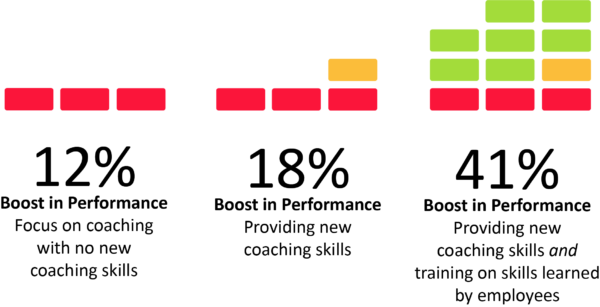
- When an organization equips managers with new coaching skills, performance improvement jumps to about 18%.
- When an organization provides managers with a combination of new coaching skills and training in the specific skills their employees learned, performance improvement skyrockets to 41%, on average.
What Should You Do Next?
Focus on preparing your managers to coach to the skills your employees are learning—providing coaching skills alone are not enough. Unless your managers can provide meaningful, constructive feedback and role clarity, based on their knowledge of the job and the desired competencies, you will lose more than half of the potential impact of the manager coaching. So, as you develop and launch any manager coaching program, ask:
- Do my managers have an effective coaching process?
- Do my managers have the necessary leadership and communication skills to coach effectively?
- Do my managers know enough about what their employees are learning to provide constructive feedback and advice?
- Have my managers had an opportunity to practice these skills before coaching employees?
- Have my senior leaders created a supportive coaching culture for our managers?
A Learning Journey That Works
Wilson Learning’s blended Learning Journey increases managers’ involvement in the learning, with embedded application challenge assignments to promote and track this approach. In fact, our research shows that adopting this feature doubled the percentage of assignments completed by learners, with 82% of assignments completed. And, 91% of learners received manager feedback and coaching, a 45-fold increase. These results clearly show the value and impact of the Learning Journey approach.
To learn more about creating effective learning journeys, feel free to get in touch with us .
Article based on: Impact of Manager Coaching on Learning Transfer by Michael Leimbach, PhD, VP of Global Research and Development, Wilson Learning Worldwide
Contact Form
- First Name *
- Last Name *
- Business Email Address *
- Company Name *
- Country * Afghanistan Åland Islands Albania Algeria American Samoa Andorra Angola Anguilla Antarctica Antigua and Barbuda Argentina Armenia Aruba Australia Austria Azerbaijan Bahamas Bahrain Bangladesh Barbados Belarus Belgium Belize Benin Bermuda Bhutan Bolivia Bonaire, Sint Eustatius and Saba Bosnia and Herzegovina Botswana Bouvet Island Brazil British Indian Ocean Territory Brunei Darrussalam Bulgaria Burkina Faso Burundi Cambodia Cameroon Canada Cape Verde Cayman Islands Central African Republic Chad Chile China Christmas Island Cocos Islands Colombia Comoros Congo, Democratic Republic of the Congo, Republic of the Cook Islands Costa Rica Côte d'Ivoire Croatia Cuba Curaçao Cyprus Czech Republic Denmark Djibouti Dominica Dominican Republic Ecuador Egypt El Salvador Equatorial Guinea Eritrea Estonia Eswatini (Swaziland) Ethiopia Falkland Islands Faroe Islands Fiji Finland France French Guiana French Polynesia French Southern Territories Gabon Gambia Georgia Germany Ghana Gibraltar Greece Greenland Grenada Guadeloupe Guam Guatemala Guernsey Guinea Guinea-Bissau Guyana Haiti Heard and McDonald Islands Holy See Honduras Hong Kong Hungary Iceland India Indonesia Iran Iraq Ireland Isle of Man Israel Italy Jamaica Japan Jersey Jordan Kazakhstan Kenya Kiribati Kuwait Kyrgyzstan Lao People's Democratic Republic Latvia Lebanon Lesotho Liberia Libya Liechtenstein Lithuania Luxembourg Macau Macedonia Madagascar Malawi Malaysia Maldives Mali Malta Marshall Islands Martinique Mauritania Mauritius Mayotte Mexico Micronesia Moldova Monaco Mongolia Montenegro Montserrat Morocco Mozambique Myanmar Namibia Nauru Nepal Netherlands New Caledonia New Zealand Nicaragua Niger Nigeria Niue Norfolk Island North Korea Northern Mariana Islands Norway Oman Pakistan Palau Palestine, State of Panama Papua New Guinea Paraguay Peru Philippines Pitcairn Poland Portugal Puerto Rico Qatar Réunion Romania Russia Rwanda Saint Barthélemy Saint Helena Saint Kitts and Nevis Saint Lucia Saint Martin Saint Pierre and Miquelon Saint Vincent and the Grenadines Samoa San Marino Sao Tome and Principe Saudi Arabia Senegal Serbia Seychelles Sierra Leone Singapore Sint Maarten Slovakia Slovenia Solomon Islands Somalia South Africa South Georgia South Korea South Sudan Spain Sri Lanka Sudan Suriname Svalbard and Jan Mayen Islands Sweden Switzerland Syria Taiwan Tajikistan Tanzania Thailand Timor-Leste Togo Tokelau Tonga Trinidad and Tobago Tunisia Turkey Turkmenistan Turks and Caicos Islands Tuvalu Uganda Ukraine United Arab Emirates United Kingdom United States Uruguay US Minor Outlying Islands Uzbekistan Vanuatu Venezuela Vietnam Virgin Islands, British Virgin Islands, U.S. Wallis and Futuna Western Sahara Yemen Zambia Zimbabwe
- Interested In: * Sales Development Leadership Development
- I would like to receive further marketing related telephone communications from Wilson Learning.
- Hidden Phone Consent
- I Do Not Agree
- Name This field is for validation purposes and should be left unchanged.
Create Your Course
How to design an effective learning path, share this article.
Everything you need to know about designing a learning path - including examples and best practices for creating structured learning journeys that work.
A learning path is the tool that can take your training program from confusing to constructive – building on knowledge incrementally to get your learners from A to B efficiently.
A learning path is designed to give learners a clear route through a training program. It breaks course content down into manageable chunks, allowing learners to easily absorb information and progress smoothly through each course.
Here’s everything you need to know about designing a learning path – including what is a learning path, what makes a good learning path and types of learning paths.
What is a learning path?
A learning path is a route that learners take through a training program. Learning paths gather together a selection of courses and transform them into a cohesive learner journey, while breaking the whole learning process into manageable chunks.
Your goal as an educator is to get your students from A to B in their learning journey. But getting your learners to their final destination requires a series of smaller steps. It’s not enough to dump all the information on learners in one go. Instead, a learning path allows you to map out how learners will move through your program and gradually acquire knowledge along the way.
For learners, a learning path provides a roadmap for how they’ll get from their current knowledge place to their desired future. It gives them a clear picture of how you will help them achieve their final learning goals and the route they will take to get there. Grab our Learning Sequence Examples and Template
Learning pathway examples
To help you understand exactly how a learning path can help you, let’s take a look at 4 learning pathway examples.

Learning paths for employees
From employee onboarding to compliance training to upskilling and more, education is an essential part of building an efficient and productive workforce.
Learning paths give you the opportunity to streamline your employee training by providing a focused approach to learning. With tools like this employee training tracker template , you can communicate employee milestones and track their progress.
Importantly, a learning path also cuts down on education-related admin. Instead of enrolling employees for individual courses, you simply add them to a learning management system and let the learning path guide them from there.
Read more on learning paths for employees and how software-company Procurify saved 15+ hours a week by building an online training academy for their workforce.
Partner education
Partners are a valuable resource for increasing sales and growing your business. A learning path can be used to simplify partner education by providing a clear process for partners to learn about your brand, improve their product knowledge and ensure compliance across-the-board.
When it comes to partner education, a learning pathway allows you to hit key onboarding targets, including:
- Gaining a sense of your partners strengths and weaknesses
- Providing partners with the documents and materials they need to sell your products
- Delivering essential brand training
- Gathering feedback from partners
Use this partner onboarding template to instantly improve your partner education.
Customer education
A learning path can also be used to improve customer education by taking customers on a structured journey. With the right learning path, you can move customers seamlessly from learning about your product to making an informed buying decision and finally helping them get the most value out of your product.
For businesses, implementing a learning path in your customer education process can help you to:
- Move leads down the sales funnel
- Provide a focused approach to learning about your product
- Help customers to better understand your product value
- Assist with product adoption
- Provide ongoing education for customers
- Improve brand loyalty
Find out more about optimizing your customer success through customer education here .
Online course businesses
If you’re building an online course business, a learning path will help you create learning solutions that stick.
As an educator, you have in-depth expertise in your subject area but you need to find a way to share that knowledge with a non-expert audience. With a learning path, you can break down your expertise into easily absorbed modules that help learners progress through your course material.
By taking learners step-by-step, you hugely increase their chances of success and improve the learning outcomes. Here’s one example of how a learning path can help you.
Example: Learning magic
Imagine you are a magician and you want to help other people become magicians too.
- Think about your total knowledge as a whole academy rather than just one course – in this case ‘how to become a professional magician’.
- Split your knowledge into different topics or bundles – for instance, card tricks, vanishing tricks, levitation tricks etc.
- Within these topics, define the skills learners need to gain in order to reach the learning goal – within card tricks, the skills might be card handling, performance skills and more
- Then define the methods you will use to pass on the knowledge for each skill – these will form the chapters and individual lessons you will teach within each course
Rather than offloading all your expert knowledge in one go, a learning path gives you the chance to simplify the learner journey.
How to design a learning path
Now you’ve heard what a learning path is and learning path examples, the next question is how to design a learning path?
Here’s a framework for designing your own learning path.
Conduct a training needs analysis
First things first, you need to do a training needs analysis. This is your chance to consider your learners’ goals and what they are currently lacking to allow them to achieve those goals.
In your training needs analysis, you might want to think about:
- What is the target audience?
- What are their learning goals?
- What is their current skill level?
- What are the main barriers to their learning right now?
By defining these points now, you can make sure you design your program in a clear, structured way.
Identify skill gaps
You can now identify the current gaps between the skills your target audience has and their desired learning outcomes . This is the time to figure out what skills your target audience lack and what they will need to achieve their goals.
Try asking yourself these questions:
- What does my target audience want to achieve?
- Where do they want to be at the end of the course?
- What does my course need to include to get them there?
- What essential skills do they need to learn?
- How will my course help?
You can refer back to your answers later to make sure your course delivers on its aims.
Define your learning goals
Now take all the information from steps 1 and 2 and turn it into your learning goal. Here you will identify the skills, knowledge and capabilities you want learners to achieve by the time they have completed your program. This is the foundation that everything is built on!
To borrow from our magician example, a learning goal might be: After completing the training, the learner will be able to perform 5 magic tricks with no assistance.
This learning goal clearly defines who will be doing the learning, what they will be able to do and the degree of mastery involved.
Create an eLearning Storyboard
Next you can create a storyboard for your course.
An eLearning storyboard allows you to map out the learning path, describing what content you will create and how you will produce the content. In your eLearning storyboard you can include:
- How you will deliver the education
- What instructional materials you will use
- What order your content will go in
- How your modules will fit together
- Who you need to work with to deliver the program
The storyboarding process is your chance to get the meaty part of your course planning sorted. In this step, you’ll figure out exactly what you need to include in your course and how you will deliver it.
Optimize content subject matter and packaging
After the initial eLearning storyboarding, you can work on optimizing your content to make sure it hits your learning goals. Refer back to the objectives you defined at the start of your process.
The important thing here is to make sure that your current learning path doesn’t overload learners with too much information all at the same time. Check out this blog on cognitive load theory to learn more.
Create steps and milestones
To refine your learning path even more, you need to build in the steps you want your learners to take. Clearly defined steps and milestones help to make the journey through your course smooth and enjoyable.
A great way to implement steps in your learning path is using a hierarchy of online learning that builds on Bloom’s taxonomy .
The hierarchy of online learning breaks learning down into six stages:
- Remembering facts
- Demonstrating understanding
- Applying learning to actual situations
- Analyzing ideas and understanding how they all fit together
- Using knowledge to propose new solutions to a given problem
- Creating, designing, and implementing new things based on the learning
This system creates a scaffold for designing your learning path. As learners move through each level, they will build on their knowledge from the previous stage. By keeping this structure in mind, you can ensure that your learning path follows a logical progression.
Read more about methods to make learning stick using Gagne’s 9 Events of Instruction.
Implement and monitor your learning path
Designing the best possible learning path is a continual process. After you’ve designed and implemented your learning path, you can monitor its performance and collect feedback from learners.
If there’s something that isn’t working, it’s a good idea to take another look at your learning path. What is missing? How can you make the journey even smoother? The best learning paths are the ones that respond and adapt to the needs of your learners.
What makes a good learning path?
Now you have a good idea of what is a learning path and how to design a learning path, let’s take a look at what makes a good learning path.
Here are some key considerations if you’re looking to make a brilliant learning path.
Produce evergreen content
For online courses to be effective, they need to be standalone with minimal input from you or the course instructors. That means you need to try and anticipate the learner’s needs and plan your learning path with those needs in mind.
One of the main reasons to implement a learning path is to reduce the amount of input that is needed day-to-day. With evergreen content, you can set learners up on the learning path and leave them to it. This makes your job easier and makes sure there’s no delays on the learners’ end.
Consider different learning styles
Remember that everyone learns differently. Not all your learners will have the same preferences when it comes to learning styles.
When you’re designing your learning path, try to create resources that cater to multiple learning styles . Think about producing a range of different content, for instance a combination of image-rich content and auditory content like podcasts or lectures. The more variety of activities and exercises you can offer the better!
Make it bite-sized
Small and simple is key! One of the main advantages of a learning path is that it allows you to break the learning journey into small bite-sized chunks.
Not only does this help to make your course easier to follow, by transforming your program into small learning steps, you also add an extra level of flexibility. Learners can take course modules one at a time, allowing them to structure their learning around their other commitments. A learning path creates a continuous journey for learners without overloading them with too much information all at once.
Learn more about Micro-Learning Strategy .
Learn how to effectively scale up your business through the power of B2B course sales in this free course:
Colin is a Content Marketer at Thinkific, writing about everything from online entrepreneurship & course creation to digital marketing strategy.
- Your Guide to Bringing Your Classroom Online Quickly and Effectively
- How To Create An Online Academy For Your Business
- The B2B Leap: Successfully transitioning from selling B2C to B2B
- How to Make a Microteaching Lesson Plan
- What Is the ADDIE Training Model? (Template + Examples)
Related Articles
25+ customer service call script examples & expert tips.
Access Customer Service Call Scripts to help your team manage inbound customer service requests and increase customer satisfaction.
How to Start a Training Business: A Comprehensive Guide to Success
Learn how to start a training business step-by-step: from ideation and planning, all the way to marketing your programs and scaling.
Learn how to create an online academy for your business and helpful steps to optimize your customer education program.
Try Thinkific for yourself!
Accomplish your course creation and student success goals faster with thinkific..
Download this guide and start building your online program!
It is on its way to your inbox
- Communication
- English Skills
- Basic Pronunciation
- Basic Vocabulary
- Step By Step Guide
- Exam Techniques
- eJOY Discovery
- Learner’s Stories
- eJOY | English Learning Blog
- eJOY Extension

Academic_Economics_Word List

New Feature on eJOY EPIC: The integration of ChatGPT

Personal feelings – Intermediate 1 – Speaking session 2

Business Meeting – Intermediate – Speaking session 01

Why the IPA is different in some dictionaries and what to…

6 Website Tự Học Digital Marketing Online Cho Người Mới Bắt…
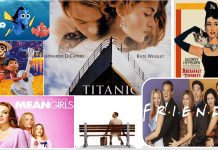
Top 15 Must-watch English Movies for Beginners
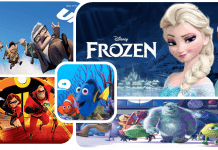
For Kids: Learn English through Film with 11 Famous Cartoon Movies

Reading IELTS – Test 1 – Cam 13

READING_IELTS 13_TEST 2
Ielts reading_ barron’s ielts_test 5, ielts reading_ barron’s ielts_test 6.
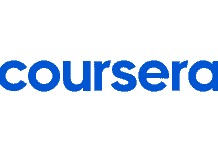
How to learn Coursera courses for free
Instructions for features on the AI Explanation pop-up
How to look up other dictionary sources on ejoy extension.
Look up feature with Pro AI dictionary on eJOY eXtension

- Learner's Stories
My English Learning Journey
I have been learning English since I was around 10 years old. Everything I was taught at school were tenses, verb conjugations, plural rules, complex grammar,… Every day my teacher required us to memorize new words by writing them down 10 times. Learning English was always a challenge for me. I got sick of vocabulary, of grammar rules, of English. And then one day, when I was probably in grade 10, my parents decided to buy me a computer. The computer has become my best friend ever since. I was amazed at how wonderful things were. The world has become a smaller place and people has become closer to each other. I could learn whatever I wanted without any help from others.
I began to listen to music, and watch TV shows. The first TV show that I watched was Hannah Montana. The TV show was just hilarious. I had picked up quite a lot of vocabulary from the show and it has become a memorable experience. It was also when I happened to fall in love with the language. I remember back then, I downloaded numerous English songs to my iPOD and listened to them everyday. I discovered many websites where people from all over the world exchanged languages and cultures with each other. I had made a lot of foreign friends there and sometimes we talked long hours about everything in life. In the first place, I thought the only reason why people learned English was to communicate with each other. Not until did I immerse into the language that I realized the very language was the best way to create a strong bond between me and the endless knowledge of the world.
I could see a significant improvement in my English skills. And thanks to English, I have learned much more about the world around me. The journey towards language fluency is not always easy and I still have a long way to go. I don’t, however, give up on it. I enjoy the journey that I’ve been through rather than the destination ahead. If you don’t know where you are, if you’re not sure what to do next, just do whatever you love. If you are struggling with learning English, then let it be! Watch movies and laugh hard, read books and think thoroughly, play games and relax.
“Never let English limits limit your world!”
RELATED ARTICLES MORE FROM AUTHOR
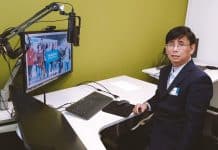
The True Masters Are Lifelong Learners

How I Fall in Love with English Language for the First Time
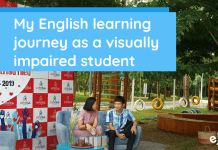
How a Visually Impaired Student Studies English

My Way from IELTS 3.5 to 5.5 with eJOY

5 Great English Books for Beginners
I am searching app to improve my English ? Ejoy is good choice for me
Oh yes , thank for your praise 😀
Comments are closed.

How to Be Kind to Yourself
Learning Journeys
Build the skills you need at your own pace., build the skills you need at your own pace.
- Early Years Staffroom
My Learning Journey
A secure place to document and reflect on your early years practise educational service.
.jpg/:/cr=t:0%25,l:0%25,w:100%25,h:100%25/rs=h:500,cg:true)
Your Learning Journey is a secure place to document and reflect on your Early Years practise. The idea is born from a child’s learning journey through Early Years. The Learning Journey starts at your starting point and goes on a journey through your career. You can add ‘professional developments’ along the way including photos, PowerPoint's, videos, spreadsheets, notes and have space to reflect on your learning and how you have adapted your pedagogy.
The Learning Journey documents everything that you would need to apply for a job, for example, your DBS number, QTS number etc. as well as your qualifications, employment history and references all in one place. The journey finishes with a future goals board.
All of this information collates into an easy to download document ready to use to present to future employers giving you the optimum head start at interview.
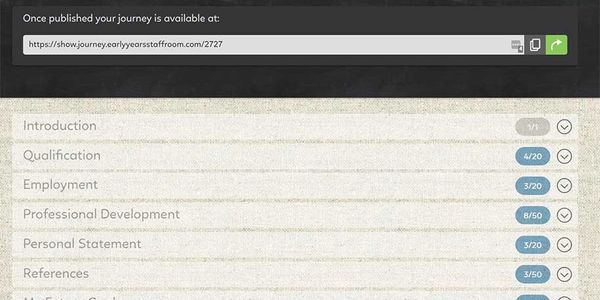
Why did we create the Learning Journey?
Reflective practice is essential to working in Early Years, it is part of everyday teaching. Outstanding practice is a cycle of constant reflecting, reviewing and adapting and improving and you Learning Journey enables you to do this.
Teaching is a rewarding but often difficult job. As a forward-thinking organisation who wants to help Teacher’s and Early Years Professionals in every way we can, we saw there was a need for an easy digital document to keep a record of your journey, keeping information secure and presentable and very easy to update as you embark on your Learning Journey.
Who can use the Learning Journey ?
All existing and new members of the Early Years Staffroom Planning & Resource website have free unlimited access to the My Learning Journey builder product.
It can be used for any position in Early Years, you don’t have to have QTS, you may find this useful if you are a Manager, Childminder or Teaching assistant. You can use this even if you are a few years into your journey, it can be started and updated at any time.
How do I know my information is safe?
We take data protection very seriously. We appreciate your journey may contain sensitive personal data. You as the user are in control of who you share with and who can see your journey by deciding who you share your journey link with. We the administrators of the website have no access to your journey unless you share it with us even though the data is stored securely on our servers. The only data which will be referenced generically from the data sources used in the journey is to determine the overall usage and data capacity limits.
What People Are Saying
Imogen roberts - early years nqt.

This is amazing for me as I’m looking to teach abroad so I can send this to schools with my application.
Natasha Hillwood - EYFS Teacher
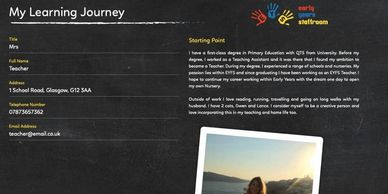
Everything in one place, and so easy to use.
My head of early years was very impressed at my appraisal. She has even asked all members of our team to start using this, to help with our professional development.
Edubox - Education Resources

We have never seen anything like it before!
The Early Years Staffroom have created a practitioners learning journey. This is perfect for when you apply for a new job with everything being in one place. It is also perfect for professionals who demonstrate best practise by reflecting regularly.
If your interested in setting up your own My Learning Journey or just want to know more about it.
Please email : [email protected]
Copyright © 2019 earlyyearsstaffroom.com - All Rights Reserved.
My Learning Journey by Early Years Staffroom
- Privacy Policy
Home — Essay Samples — Education — Learning — My Learning Experience: Growth and Discovery
My Learning Experience: Growth and Discovery
- Categories: Learning Personal Experience
About this sample

Words: 908 |
Published: Sep 12, 2023
Words: 908 | Pages: 2 | 5 min read
Table of contents
Early learning: the foundation, elementary school: the wonder years, middle school: challenges and growth, high school: exploring passions, college and beyond: lifelong learning, conclusion: embracing the journey.

Cite this Essay
Let us write you an essay from scratch
- 450+ experts on 30 subjects ready to help
- Custom essay delivered in as few as 3 hours
Get high-quality help

Verified writer
- Expert in: Education Life

+ 120 experts online
By clicking “Check Writers’ Offers”, you agree to our terms of service and privacy policy . We’ll occasionally send you promo and account related email
No need to pay just yet!
Related Essays
1 pages / 649 words
1 pages / 351 words
7 pages / 3203 words
3 pages / 1304 words
Remember! This is just a sample.
You can get your custom paper by one of our expert writers.
121 writers online
Still can’t find what you need?
Browse our vast selection of original essay samples, each expertly formatted and styled
Related Essays on Learning
Service learning is a teaching method that combines academic instruction with meaningful community service. Through service learning, students can apply what they have learned in the classroom to real-life situations, while also [...]
Language learning has become an essential tool for individuals to succeed in their personal and professional lives. As a multilingual AI language model, I understand the importance of language learning firsthand. In this essay, [...]
Lifelong learning refers to the process of acquiring knowledge and skills throughout one's life, beyond the formal education years. It encompasses both formal and informal learning opportunities, such as enrolling in courses, [...]
A. In conclusion, learning is a crucial process that enables individuals to grow, adapt, and succeed in various areas of life.B. This essay has explored the concept of learning, its different types, and its significance, as well [...]
Learning is a fundamental aspect of human existence, and it is a complex process that involves multiple stages of information processing. When we hear something for the first time, our brains must first encode the information, [...]
Although they are very young, the responsibility of securing their future has been given solely to students. They receive guidance from parents and teachers but most of the work must be done by them. Therefore, to be able to [...]
Related Topics
By clicking “Send”, you agree to our Terms of service and Privacy statement . We will occasionally send you account related emails.
Where do you want us to send this sample?
By clicking “Continue”, you agree to our terms of service and privacy policy.
Be careful. This essay is not unique
This essay was donated by a student and is likely to have been used and submitted before
Download this Sample
Free samples may contain mistakes and not unique parts
Sorry, we could not paraphrase this essay. Our professional writers can rewrite it and get you a unique paper.
Please check your inbox.
We can write you a custom essay that will follow your exact instructions and meet the deadlines. Let's fix your grades together!
Get Your Personalized Essay in 3 Hours or Less!
We use cookies to personalyze your web-site experience. By continuing we’ll assume you board with our cookie policy .
- Instructions Followed To The Letter
- Deadlines Met At Every Stage
- Unique And Plagiarism Free
- Share full article
For more audio journalism and storytelling, download New York Times Audio , a new iOS app available for news subscribers.

- April 18, 2024 • 30:07 The Opening Days of Trump’s First Criminal Trial
- April 17, 2024 • 24:52 Are ‘Forever Chemicals’ a Forever Problem?
- April 16, 2024 • 29:29 A.I.’s Original Sin
- April 15, 2024 • 24:07 Iran’s Unprecedented Attack on Israel
- April 14, 2024 • 46:17 The Sunday Read: ‘What I Saw Working at The National Enquirer During Donald Trump’s Rise’
- April 12, 2024 • 34:23 How One Family Lost $900,000 in a Timeshare Scam
- April 11, 2024 • 28:39 The Staggering Success of Trump’s Trial Delay Tactics
- April 10, 2024 • 22:49 Trump’s Abortion Dilemma
- April 9, 2024 • 30:48 How Tesla Planted the Seeds for Its Own Potential Downfall
- April 8, 2024 • 30:28 The Eclipse Chaser
- April 7, 2024 The Sunday Read: ‘What Deathbed Visions Teach Us About Living’
- April 5, 2024 • 29:11 An Engineering Experiment to Cool the Earth
The Sunday Read: ‘What I Saw Working at The National Enquirer During Donald Trump’s Rise’
Inside the notorious “catch and kill” campaign that now stands at the heart of the former president’s legal trial..
By Lachlan Cartwright
Read by David Linski
Produced by Jack D’Isidoro and Aaron Esposito
Narration produced by Anna Diamond
Edited by John Woo
Original music by Aaron Esposito
Engineered by Corey Schreppel and Steven Szczesniak
Listen and follow The Daily Apple Podcasts | Spotify
At the center of the criminal case against former President Donald Trump in Manhattan is the accusation that Trump took part in a scheme to turn The National Enquirer and its sister publications into an arm of his 2016 presidential campaign. The documents detailed three “hush money” payments made to a series of individuals to guarantee their silence about potentially damaging stories in the months before the election. Because this was done with the goal of helping his election chances, the case implied, these payments amounted to a form of illegal, undisclosed campaign spending. And because Trump created paperwork to make the payments seem like regular legal expenses, that amounted to a criminal effort at a coverup, argued Alvin Bragg, the district attorney of Manhattan. Trump has denied the charges against him.
For Lachlan Cartwright, reading the indictment was like stepping through the looking glass, because it described a three-year period in his own professional life, one that he has come to deeply regret. Now, as a former president faces a criminal trial for the first time in American history, Cartwright is forced to grapple with what really happened at The Enquirer in those years — and whether and how he can ever set things right.
There are a lot of ways to listen to ‘The Daily.’ Here’s how.
We want to hear from you. Tune in, and tell us what you think. Email us at [email protected] . Follow Michael Barbaro on X: @mikiebarb . And if you’re interested in advertising with The Daily, write to us at [email protected] .
Additional production for The Sunday Read was contributed by Isabella Anderson, Anna Diamond, Sarah Diamond, Elena Hecht, Emma Kehlbeck, Tanya Pérez, Frannie Carr Toth and Krish Seenivasan.
Corey Schreppel leads the technical team that supports all Times audio shows, including “The Daily,” “Hard Fork,” “The Run-Up,” and “Modern Love.” More about Corey Schreppel
Advertisement

IMAGES
VIDEO
COMMENTS
My Learning Journey - Atos
A learning journey map helps you chart your learning experience over time and identify the moments when you soared effortlessly and when you ran into challenges. It is a tool to examine your learning objectively, discover your strengths, and work through your challenge areas.
Learn how to create a successful learning journey with top-notch learner experiences by mapping your audience, skills gaps, and goals. Follow these six steps to design a learning journey that works for your audience and meets their needs.
Learn how to develop a learning journey that benefits both the individual and the organization, and helps employees master their skills, learn new technologies or further their education. Find out the best practices, benefits and challenges of creating a learning journey with formal and informal training programs.
A learning journey refers to a series of training modules that use a variety of techniques to help employees hone their professional abilities. Employers and hiring managers often create learning journeys to improve the skills of both new and existing employees while optimizing the business's overall efficiency. Knowing more about the steps and ...
Provide social learning so that learners can collaborate with others progressing in the learning journey, sharing knowledge and experiences. Parting Thoughts Effective behavior change occurs over time as desired competencies and behaviors are reinforced through a blend of formal and informal training.
Throughout the learning journey, employees need a safe space to participate, digest, apply, and experiment with the new knowledge they're gaining through the learning journey. The experimentation and feedback loop are key to achieving behavior change. Ongoing connects. Design learning journeys that include more than formal training events.
From The Best Way to Master a New Skill? Try This Creative Approach. , Nov 03, 2021. Find new ideas and classic advice on strategy, innovation and leadership, for global leaders from the world's ...
Learning and development professionals have enormous influence in organizations. It is in carefully and thoughtfully planning a high-impact learning journey that we move from good courses to great training experiences with the power to change lives. For additional help planning your learning journey, check out our implementation guide.
Learning Journeys is a tool that helps you reflect on your learning experiences and goals. It guides you through four steps: Purpose, Plan, Do and Don't forget.
A learning journey is a comprehensive, continuous process of acquiring knowledge and skills, designed to facilitate long-term behavior change and professional development. Unlike traditional training, which is often a one-time event, a learning journey encompasses a series of interconnected learning experiences. These experiences combine formal ...
The key is that L&D professionals create a structure that makes learning happen better. For example, giving leaders time to process what they're learning on their own, and then coming back together in peer learning groups to discuss what they learned. This is just one way to ensure self-directed learning sticks. 3.
Start a hobby. Learning can occur in many forms and situations. Starting a new pastime such as playing tennis, learning to paint, riding a horse, or listening to new types of music can provide a fun opportunity to reflect on what and how you are thinking and learning. 2. Look after a pet.
A Learning Journey That Works. Wilson Learning's blended Learning Journey increases managers' involvement in the learning, with embedded application challenge assignments to promote and track this approach. In fact, our research shows that adopting this feature doubled the percentage of assignments completed by learners, with 82% of ...
This being said, you don't need a perfectly manicured set of notes. Reliable primary sources to start your learning journey are enough. My two-step learning process. For each of the topics above, I follow and repeat the two-step learning process as below. 1. Deep learning and detailed note-making
A learning path is a route that learners take through a training program. Learning paths gather together a selection of courses and transform them into a cohesive learner journey, while breaking the whole learning process into manageable chunks. Your goal as an educator is to get your students from A to B in their learning journey.
If you have 3 classes per week along with homework to do before each, it means you have to study at the very least 4 times per week (if you have class three days in a row). Chances are, however ...
November 20, 2017. 18513. 2. I have been learning English since I was around 10 years old. Everything I was taught at school were tenses, verb conjugations, plural rules, complex grammar,…. Every day my teacher required us to memorize new words by writing them down 10 times. Learning English was always a challenge for me.
Our SAP Learning Journeys provide easy-to-navigate, learning content to help you gain the skills you need and prepare for an SAP Certification. Our Learning Journeys cover a wide range of topics, including UX, software development, data and analytics, cloud capabilities, and more. With easy-to-follow lessons, hands-on practice, and expert ...
Define your learning journey, revisit it often and change it as much as needed. Be transparent in your journey and take others along with you. Gain and share your experiences. Create relationships ...
My Learning Journey is a secure online tool that lets you record and reflect on your Early Years teaching journey, from your starting point to your goals. You can add professional developments, photos, videos, notes and more, and download a document to use for your job applications or appraisals.
My learning experience has been a journey filled with growth, challenges, and moments of inspiration. Along the way, I have been fortunate to have supportive teachers, mentors, and peers who have guided and inspired me. Each phase of my educational journey has contributed to my personal and intellectual development, shaping the person I am today.
Oracle MyLearn — your personalized learning experience. Build new skills with Oracle Cloud training courses and advance your career with an Oracle Certification.
The Sunday Read: 'What I Saw Working at The National Enquirer During Donald Trump's Rise' Inside the notorious "catch and kill" campaign that now stands at the heart of the former ...